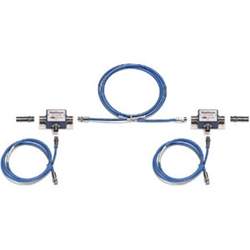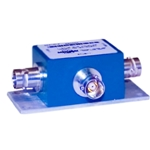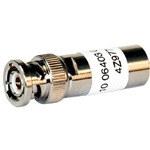Mil-STD-1553
The history and basics of the Milbus 1553b
The Mil-Std-1553B or Milbus is a standard defining characteristics of a serial multiplex data bus. The standard itself is a set of requirements which cover all aspects of the bus, from mechanical to electrical and functional aspects. The bus aimed at the beginning to interconnect through a single medium avionics subsystems.
The first draft of a standard was published by SAE in 1968 and was adopted in 1973 by the US Air force, the Mil-Std-1553A was released in 1975 and the B version was adopted in 1978. In the beginning it was a bus used in military planes but soon after, its utilization extended to aerospace and to other field.
Several organizations adopted the Milbus (US Force, NATO, MoD, NASA ESA, etc. Some requirement are very precisely defined while others are subject to interpretation and tailoring, leading to organization-specific tailored released versions of the standard with their own interpretation and reference (NATO, MoD in UK).
The Bus is a terminated transmission line based on a twisted and shielded pair cable, Bus controller and the Remote terminals are connected to the line through stubs and couplers. The Bus works has a fixed data rate of 1 Mbits/s and is typically implemented as a dual standby redundant architecture.
MIL-STD-1553 defines three types of bus users, called terminals: Bus Controller (BC), Remote Terminal (RT) and Bus Monitor (BM). The transaction on the bus is of type Command/Response. The BC acts as the master and initiates all the transactions. The RTs, commanded by the BC, provide the interface between 1553 bus and the relevant unit/sub-system. The BM is passive and record the bus traffic.
Use in space and ESA's own version of the Milbus: ECSS-E-50-13C
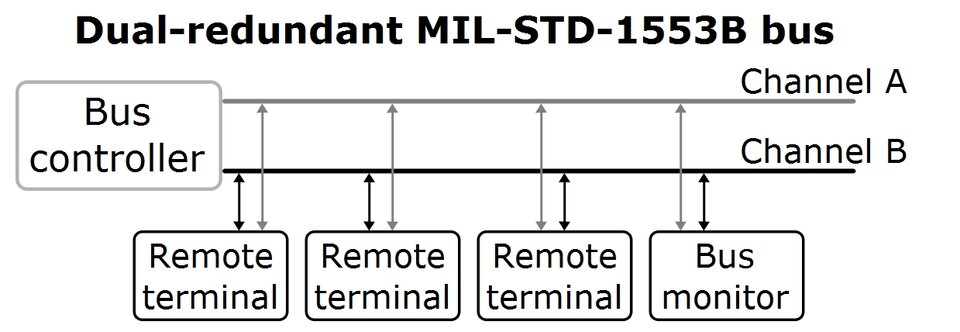
In Space applications, the milbus has been used in platforms as well as in payloads and is currently used on the International Space Station (ISS) and in many other European and ESA spacecraft like Ariane 5, VEGA, Sentinels, IXV, Bepi Colombo, GAIA, Gallileo, SmallGeo, ATV, etc. ESA issued the ECSS-E-50-13C standard with the goal of adapting a number of Mil-STD-1553B requirements to European space applications and to extend the capabilities of the standard beyond the data link layer in order to manage large set of data, time distribution, QoS, etc.
The standard incorporates powerful means to monitor and control the data integrity by its ability to detect several types of error: parity, Manchester code, bit count, word count, etc.
There are several way to organise the data transfer on the bus. The message occurrence can be periodic or event driven. The basic transmission unit is the message slot. The transmission organisation can follow a flat or a hierarchic schematic. In the later case, the bus bandwidth utilisation is structured in frames (major frame, minor frame sub frame etc..) The cycle can be synchronised with the on-board time clock.
Validation
A number of Validation and Production Test Plan are available and defining a standard set of tests covering terminals and systems. The test plan aims at verifying compliance to the standard, characterizing data-bus I/F of a terminal and check its margins and limitations. The SAE maintains the suite of standards outlined below:
- SAE AS4111 Validation Test Plan for the Digital Time Division Command/Response Multiplex Data Bus Remote Terminals
- SAE AS4112 Production Test Plan for the Digital Time Division Command/Response Multiplex Data Bus Remote Terminals
- SAE AS4113 Validation Test Plan for the Digital Time Division Command/Response Multiplex Data Bus Controllers
- SAE AS4114 Production Test Plan for the Time Division Command/Response Multiplex Data Bus Controllers
- SAE AS 4115 Test Plan for the Digital Time Division Command/Response Multiplex Data Bus System
Interfaces
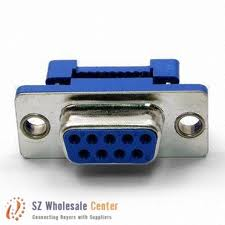
Each Mil-Std-1553 B interface basically will comprise three elements: the chip implementing the data link layer, the transceiver and the transformer. Several manufacturers worldwide produce Mil-Std-1553B components. Concerning the data link layer, some chips offer, beside the standard itself, extended capabilities like memory and FIFO management, framing management, fault management and interface (I/F) to host. Other alternative is to use available IP Cores which can be implemented in FPGA or System-on-Chip (SoC).
Here are some examples of commercial connectors and interfaces of the Milbus


